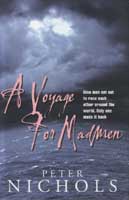Book Review
A
Voyage For Madmen
by Peter Nichols
On a still day, if
one leans over the gunwale, one will see the world as
a distorted image. This book is the story of how the sea
distorts men's worlds. |
A Voyage For Madmen covers the
story of the 1968 Sunday Times Golden Globe race in which nine
men, inspired by Sir Francis Chichester's world circling endeavour
in Gipsy Moth IV, raced each other to be the first and the fastest
to circumnavigate the globe none-stop. It is a dark and gripping
tale, and although entirely factual in content, reads with the
fluid ease of the very highest quality of fiction writing. Indeed,
the actions and behaviour of these men, and certainly some of
the craft in which they attempted the circumnavigationm make
one wish this were fiction.
 The
first contact we have with the story is a list of characters
giving the barest details on boats and men. This is immediately
followed by a well-written introduction which sets the story
in context both with the decade in which it took place, but
also against the world in which we now live.
The
first contact we have with the story is a list of characters
giving the barest details on boats and men. This is immediately
followed by a well-written introduction which sets the story
in context both with the decade in which it took place, but
also against the world in which we now live.
This past, the book opens studiously, briefly
covering topics as diverse as psychology, geography, history
and politics. This is not the wade it may sound, it discreetly
provides the reader with all the background knowledge necessary
to experience this book to it's fullest extent. From here, the
book takes on the form that will persist to the end: within
the book are ten stories - the story of each competitor, and
the story of the competition itself (which attained it's own
character and momentum as time progressed).
And what a study! The characters are drawn with
delicate precision; almost within two paragraphs we feel we
know these men, and we are riding piggy-back experiencing their
successes and frustrations and learning about them as they learn
about themselves. Nichols does not make the error of labouring
any point, relying on the reader's intelligence to pick out
the delicate shades of his narrative. We see the Gallic bullishness
of Moitessiere, and the Anglian arrogance of Knox-Johnston,
both men in love with the sea, contrasted effectively against
the brutality of Blyth, or Tetley's quiet Navy efficiency, all
delicately played out in captivating prose.
Having watched these men decide to enter the race
and prepare their craft for the sea we enter, naturally, by
far the most interesting passages of the book. For those who
enjoy a Gipsy Moth Circles The World-esque nautical romp, there
is certainly a great deal to take from this book, but the more
interesting story lies in watching these men learn about themselves:
Carozzo, the Italian entrant never leaves port; Moitessiere
by contrast, never comes back, having found in the sea his desired
element. Where Knox-Johnston aquires strength from his endeavour
in his equally strong boat, we see Crowhurst in gradual decline.
The book builds in tempo as the racers drop out
of the running one by one, until just four are left, and as
the last of the racers clear Cape Horn the book, like a Cape
Horn sea, delivers a number of hard shocks that are hard to
recover from. I will not spoil the book for you by revealing
these, but as with great fiction, the ending is not as one could
possibly have imagined.
This is a dark and brooding book about the fallibility
of humanity, it's frailty against the elements, and against
itself. When I first opened the book I thought that the title
was designed for headline grabbing, but as the author frequently
asserts, normal people do not do this sort of thing, these truly
were madmen! That Nichols has selected a story that is in itself
difficult to put down is not to play down the mastery with which
he manipulates and presents the story. On closing the cover
on the final page, one knows that one has experienced a masterpiece
of not only nautical literature. There is something here for
anyone with an inquiring mind, if they have an interest in the
sea or not.
A must-read, I cannot recommend it highly enough.

